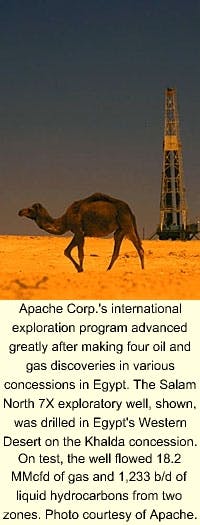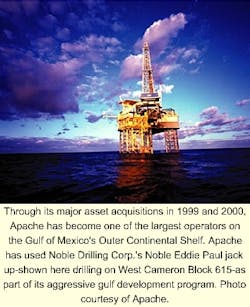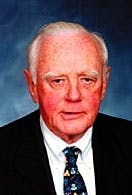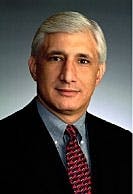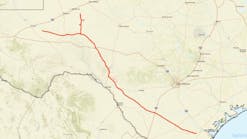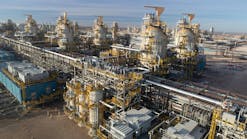Apache grows through strategic acquisitions, contrarian philosophy
This article is part of a management-issues special report, Oil Companies: Large and Small, that continues on p. 64.
Apache Corp.'s international exploration program advanced greatly after making four oil and gas discoveries in various concessions in Egypt. The Salam North 7X exploratory well, shown, was drilled in Egypt's Western Desert on the Khalda concession. On test, the well flowed 18.2 MMcfd of gas and 1,233 b/d of liquid hydrocarbons from two zones. Photo courtesy of Apache.
Apache Corp. has reached a critical mass as of late, metamorphosing into a "superindependent" through a succession of carefully selected and acquired assets located in or near its core areas of operation. In doing so, the Houston-based independent has reaffirmed actual and projected gains in production, reserves, earnings, and cash flow.
In mid-September, Apache executives announced an expected 25% increase in production for 2000 vs. 1999 and a 20% gain in reserves year-over-year. The company's net income for the first half of 2000 has already surpassed all of that in 1999.
Behind Apache's rapid growth, many financial analysts contend, lies a seemingly uncanny, contrarian "sixth sense" of knowing just which assets to buy and which to sell, and-perhaps most importantly-exactly when to do so.
Apache executives tout this corporate-wide contrarian philosophy-their proclivity to 'zig' while others 'zag'-as the backbone for the company's decision-making processes. In addition, the company's focus on the long-term picture, executives say, also plays a vital role in its successes.
"It's terribly important to us that we're trying to build this company for the long term," explained Raymond Plank, chairman, chief executive, and founder of Apache. "Our strategy tends to support what we think is best for the shareholders in the long term, even if we take it on the chin in the short term.
"We're trying to grow this company for the lasting benefit of shareholders, and we're trying to do that within a pretty positive internal culture, although externally we don't much care whose toes we step on. That's our nature.
"Our culture is very, very important to us. And because we're focusing on the long term, we tend to come across-even to ourselves-as pretty contrarian," Plank said.
Apache Pres. and Chief Operating Officer G. Steven Farris explained further: "One of the things that we've been able to do over the years is build core areas rather than just look for prospects internationally-we build core areas that we feel have some lasting presence because we're trying to build this company to last."
Recent acquisitions
Through its major asset acquisitions in 1999 and 2000, Apache has become one of the largest operators on the Gulf of Mexico's Outer Continental Shelf. Apache has used Noble Drilling Corp.'s Noble Eddie Paul jack up-shown here drilling on West Cameron Block 615-as part of its aggressive gulf development program. Photo courtesy of Apache.
So far this year, Apache has spent $867 million on acquisitions-over and above a proposed $850 million capital spending program-according to a company official.
As recently as last week, Apache, along with Royal Dutch/Shell Group, proposed to purchase assets from a subsidiary of New Zealand's Fletcher Challenge Energy in the Western Canada Sedimentary Basin and Argentina for $600 million, although the deal has since been rejected by the New Zealand Commerce Commission (OGJ Online, Oct. 10, 2000, and Oct. 12, 2000).
The timing behind purchasing properties, Plank says, becomes particularly important during times of extreme fluctuations in oil and gas prices. For example, as commodity prices were bottoming out at the turn of 1998-99, he recounts, Apache had not made any significant acquisitions for a period of time, before coming into two sizeable ones in 1999. These were the May 1999 purchase of 22 producing fields in the Gulf of Mexico from Shell Exploration & Production Co. for $715 million and the acquisition of assets in Alberta, British Columbia, and Saskatchewan from Shell Canada Ltd. for $517 million shortly thereafter.
In early 2000, Apache purchased assets in western Oklahoma and the Texas Panhandle from Crescendo Resources LP, Amarillo, Tex. Then, during midyear, it acquired South Texas and Permian basin assets for $320 million from Collins & Ware Inc., Midland, Tex. (OGJ Online, June 14, 2000).
"I don't think the world has caught up yet to the real change that has taken place in Apache between the two Shell acquisitions and the [other] acquisitions that we've made this year," Plank said. "This company is a very different animal than it was at the end of 1998, when prices were low and when Apache had sold down some of its production."
Apache's second quarter report describes their contrarian strategy at the time: "When others were overreaching, we trimmed our sails, strengthened our balance sheet, and set the stage for acquisitions that have provided surging production at a time of strong oil and gas prices."
Strategic groundwork
Apache plans to continue to prosper under a dual-track strategy, Plank told attendees at the John S. Herold Inc.-sponsored Pacesetters Energy Conference in late September. Under such a plan, Plank said, Apache would pursue mainly an acquisition and exploitation approach in the US and parts of Canada, while in other sections of Canada and elsewhere abroad, the company would function principally as an exploration firm. Again citing Apache's contrarian thinking, Plank said, "What we don't do is as important as what we will do."
Along with building a strong asset base in core areas of operation, Plank added that Apache would keep a close watch on service costs in the US. "When service costs are too high," he said, "we have and will continue to curtail drilling expenditures and prune assets even more vigorously."
Plank told Oil & Gas Journal that Apache had made the decision a number of years ago to acknowledge that-irrespective of technological advances, particularly those in the field of drilling-the US Lower 48 is in a steep decline. What logically follows, Plank says, is Apache's curtailment of drilling in North America's onshore arena, once steeper service costs become an issue, which is something Apache has already begun to observe. "If they [service companies] cut our profitability by trying to get us to pay more, it would be stupid for us [to spend more just] for a short-term benefit and to look good to investors on production growth," Plank said.
"In the [current commodity] environment that we're in," Farris said, "obviously, we're going to start seeing some pressure on service costs. And the real question is: Can you still generate a good margin? That will continue to be an issue ifellipseprices stay in these [high] ranges because they are linked: when prices are higher, costs will go higher."
Apache uses its core-area approach to monitor curtailment of its costs. "If we can increase volume, control costs, and the prices are okay, this damn thing is a money machine," Plank said.
"For example, when we bought Collins & Ware [Inc., in July for $320.3 million], those were pretty good-size acquisitions [of gas producing properties in the Permian basin and South Texas]. Yet we cut one foreman and 23 pumpers. The rest of it just plops right into our core area. Now if we went outside our core area to California, not only would we have to keep all of the field hands, but we'd probably have to add more supervisory capability, too. We've got a team that knows our culture, knows the style, and is just gung-ho-they're driven to drive this company on," he said.
Another element to Apache's strategic groundwork is its sense of urgency, explains Farris. "When we buy something, most people do not move as fast as we do and get things done." Although, Farris admits, every transaction carries a double-edged sword: "One thing is, maybe we make the mistake, but we're making movement," he said.
International operations
Apache's international areas of operation-particularly in Egypt and Western Australia-continue to take on more integral roles in the company's portfolio. One advantage that Apache has when operating in territories outside the US, Farris says, is that its relative size makes competing with the majors a possibility.
"Obviously, as we get bigger, we continue to have to look for bigger targets," Farris said.
And, both in Egypt and Australia, Farris says, the company has the opportunity to continue to move up the scale in terms of size.
For instance, Farris explains, when Apache entered Egypt's Western Desert in 1995, the firm-as was the case with most operators in the area-wasn't even looking offshore. Then Egypt recently announced proved reserves of about 45 tcf of gas in the offshore Delta region, Farris said. A sizeable portion, about two-thirds, of Apache's Egyptian acreage, called West Mediterranean, is offshore, Farris explains. Now, the area has become a hot item for Apache, because it's looking for hundreds of millions of barrels of oil there instead of just 50 million bbl. Apache expects to have a rig on the West Mediterranean prospect in the spring of 2001, Farris said.
During the first quarter of this year, Apache made four discoveries in Egypt on four concessions-West Mediterranean, East Bahariya, Khalda, and Khalda Offset (OGJ, Feb. 14, 2000, p. 33; Feb. 21, 2000, p. 34; and Mar. 13, 2000, p. 32). Plank says that he expects certain of these discoveries to come on line within a year-some of them as soon as the fourth quarter. "We're trying to get the Egyptians to let us produce the gas into the line at 25 MMcfd and take around 3,000 b/d of liquids with it. The oil means more to the country at this point, with prices where they are, than the natural gas does. It's money out of their mouths to pay for the gas, but it's money into their pockets with the oil that's sold in international markets. So we should have their cooperation there.
"Even a [small] well in Egypt is likely to make a couple of million barrels. We say this is the year of the drill bit. We got off to a pretty fast start in January-February when we made a slew of discoveries," Plank said.
With regard to well size, Apache is applying the same strategy in Australia, Plank says. "We get our infrastructure in. If you've got your infrastructure in, it can make a 35 million bbl well as profitable as one of 60-70 million bbl in another area where you can serve only one field. It's the fields around that help pay off," he said.
"When you are where there are good rocks in the first place, in a country where the size of the concession is large enough that your competitors can't come in and corner-shoot you and drain your reservoir, those conditions are strongly favorable to us."
Apache currently owns 66-68% of the Linda prospect, Plank explains, which is located on Australia's North West Shelf only 14 km from Varanus Island, where the company has a major hub.
"The Australians haven't done much drilling for stratigraphically trapped oil and gas up against faults. So this was a high-risk prospect. We got it down about as far as we were going to get it, because they were trying to run pipe, and it started to blow out on us. They cemented it off and eventually drilled out the cement," Plank said.
The well tested at a choke-restricted 35 MMcfd of gas, Plank said, but he suspects that a larger choke would have permitted a flow of more than 100 MMcfd. The pay sand was 91 m thick, as shown by an electric log, or about 280 ft of pay, Plank explains.
"So we don't have to go to the deep water of the Gulf of Mexico for large-volume wells. This is a very large structure. It will take a lot of evaluation, but the size and configuration, from what our seismic data show, says this has the potential of being a very large possible find," he said.
Linda is a brand new play concept, Farris explains. It's significance is that the well could happen up and down Apache's acreage position in Australia, he says.
On the flip side of operating in Australia, Farris says, is that one of Apache's concerns is that gas in Australia, in terms of marketing, goes in stair-steps and not in a straight, upward line. "We look for oil," Farris said, "but as we continue to look for oil, we also find natural gas, and so we continue to look for markets in an area [that are] an industrialized-type market for natural gas."
Apache is planning to drill an appraisal well to Linda beginning this month, Farris said.
Looking into LNG markets, Farris said that Apache is just not a big enough LNG player yet but may be 2-3 years from now. "Most things are an evolution, and if you try to plan everything you do every day, you sometimes miss the obvious," Farris said.
Outlook
Although Apache expects increased production in the coming years, the company says that it realizes the eyes of the financial community are focused nowadays on actual return on investment.
"We've looked at that [return on investment] all along, and we've been sick," Plank said. "We are doing everything we can to improve it. And the biggest way to improve it is to increaseellipseproduction and make sure that [general and administrative expenses] don't go up.
"If you can increase your volumes and you can perform better, you've got more commodities over which to spread your costs and the inflation that you do have in your costs. If you're growing fast and you're earning rapidly, the month that is the most important to you is the last one in the quarter, not the first one; the last one in the half-year, not the first or even the average.
"What we can be very confident of is that our volumes are going to be substantially higher," Plank said. "There's a [financial analyst] outfit out there that says Apache will have $10.07/share of cash flow this year and will have $10/share in 2001. We, on the present strip pricing, will be above $13/share cash flow this year.
"So if you take the present strip pricing and if you have what we anticipate our volumes will be, I don't see any reason not to grow more than 10% in 2001, almost any way you slice it."
Fletcher purchase
If its most recent asset acquisition goes through, Apache stands to add to its asset base 713 bcfe of natural gas, or about 12% of its current proven reserve base.
"This strategic acquisition increases our natural gas exposure in one of our international core areas at a price of 84¢/Mcf equivalent, based on proved reserves alone," Farris said.
"Apache Corp. has been a very aggressive acquirer of assets over time, and this year in particular," Lehman Brothers analyst Thomas R. Driscoll told radiowallstreet.com following the proposed purchase announcement. The 84¢/Mcfe price that Apache paid seems to be an "exceptionally good price, particularly in the strong commodity price environment we're looking at," Driscoll said.
"Apache has announced several deals at prices per Mcf-equivalent or per bbl-equivalent, that are very close to the prices in this transaction. But the deal looks better than I would have expected," he said.
Currently, Lehman has an outperform rating code on Apache with a price target of $65/share, which they will be reviewing.
Meanwhile, Credit Suisse First Boston (CSFB) raised its 12-month price target on Apache to $75/share from $70. CSFB analyst Phillip Pace said, "With 713 bcf in proven reserves, the acquisition priceellipseis very attractive, in our view.
"The assets complement Apache's existing position in Canada and increase its production in the region over 80%," Pace said.
"It's terribly important to us that we're trying to build this company for the long term. Our strategy tends to support what we think is best for the shareholders in the long term, even if we take it on the chin in the short term."
Raymond Plank
Chairman, CEO, Founder
"One of the things that we've been able to do over the years is build core areas rather than just look for prospects internationally-we build core areas that we feel have some lasting presence because we're trying to build this company to last."
G. Steven Farris
President, COO
